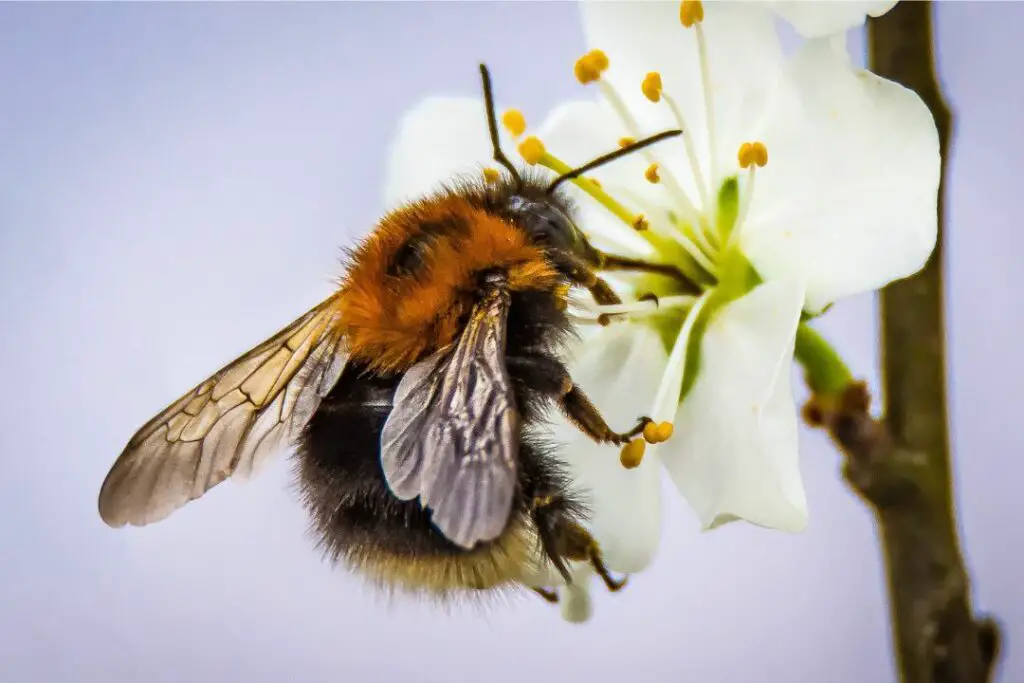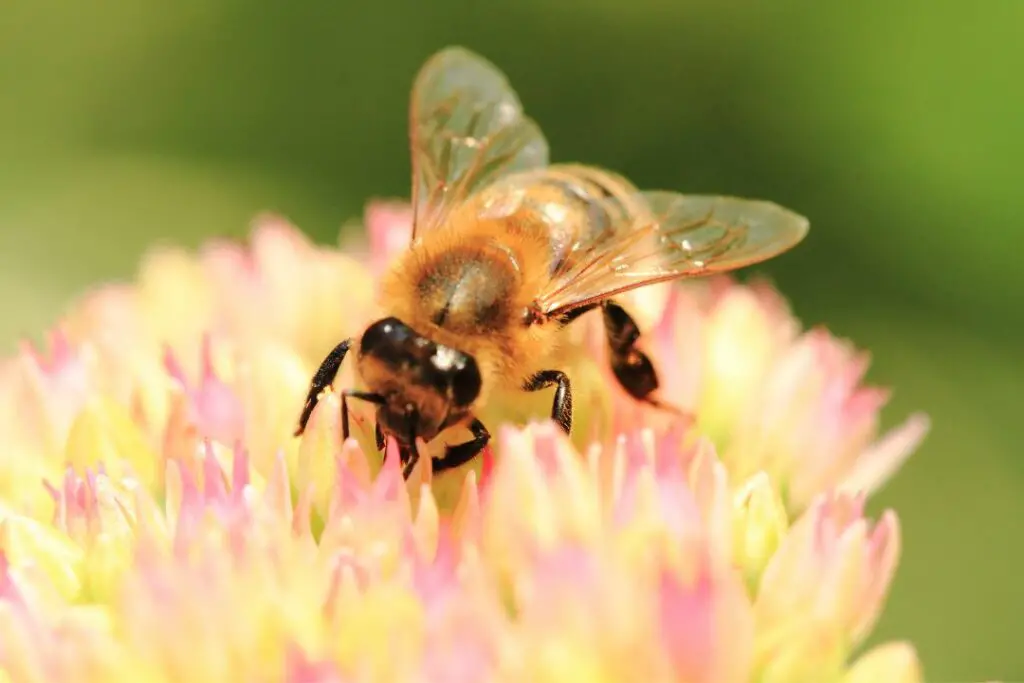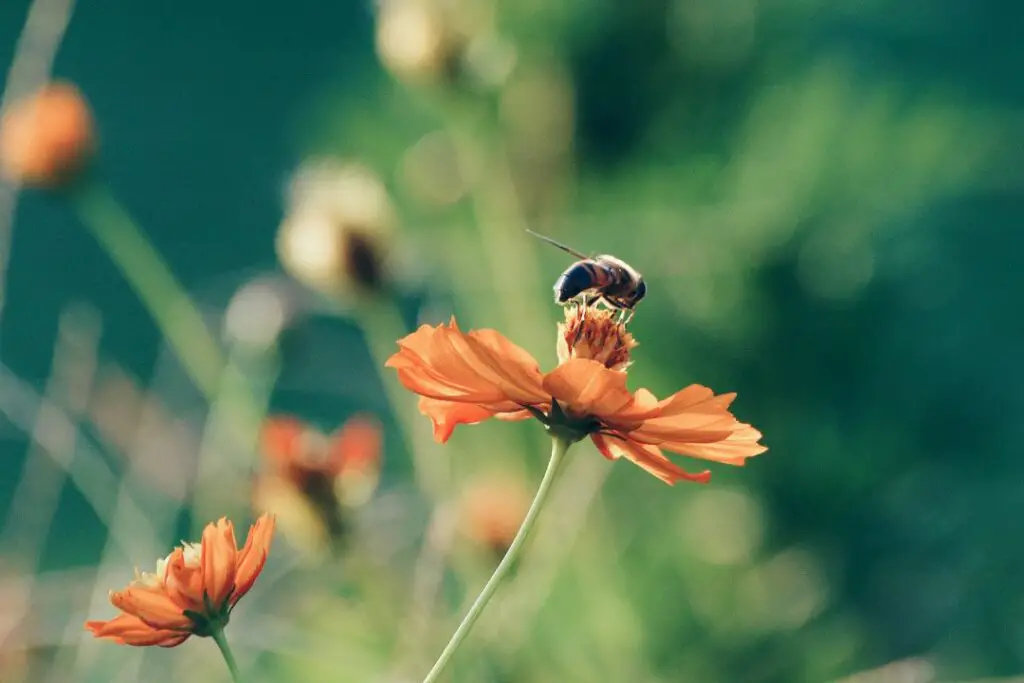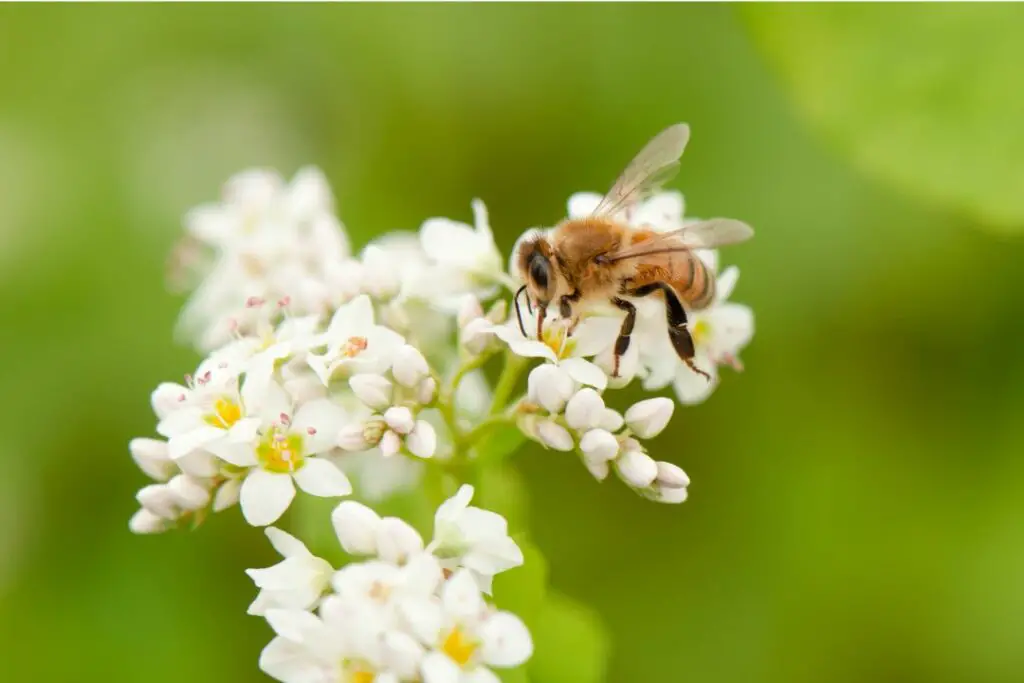Last updated on January 17th, 2024 at 01:15 pm
Yes, bees poop, poo, and defecate, just like us humans; it’s an essential bodily function for removing waste from the body.
Now we know the simple answer, let’s dive into the fascinating world of bees and their ingenious waste management methods.
How Do Bees Poo?
Like us, defecating is essential to bee life, but it all starts with the two essential building blocks of bee nutrition.
*Additional reading – Do bees fart? Find out in our definitive guide

Consuming nectar and pollen
Bees consume nectar as a carbohydrate-rich energy source that helps them carry out their day-to-day tasks of foraging, nursing and defending the hive.
But nectar alone isn’t enough to keep a bee alive and thriving.
Pollen grains get mixed with various enzymes, secretions and wax to create ‘bee bread’, a protein-rich snack that can be stored within the nest or hive for later consumption.
The digestive process
When a bee consumes food, it travels through its body before eventually being expelled as poop on the other side.
| Part | Function |
|---|---|
| Foregut | Collects nectar and pollen, temporary storage |
| Midgut | Digestion and absorption of nutrients |
| Hindgut | Waste storage and nutrient absorption |
Its digestive functions are split into three separate parts:
- Foregut: The first part of the digestive system, including the mouthparts, oesophagus, and crop. This helps the bee collect nectar and pollen, passing through the oesophagus into the crop, a storage organ where the bee temporarily holds the collected nectar.
- Midgut: The midgut is responsible for the digestion and absorption of nutrients. Enzymes secreted in the midgut break down the nectar and pollen into simpler compounds, which are absorbed into the bee’s body.
- Hindgut: The hindgut is the final part of the digestive system, consisting of the intestine and rectum. The hindgut’s main function is removing water and absorbing the nutrients from the digested food.
Waste products
Once the digestive process is complete, the waste is stored in the hindgut until the time comes to expel it from the bee’s body. More on this later.
Enzymes
Now we know how waste is processed in a bee’s body let’s dive deeper into the microscopic world of enzymes that make bee digestion a smooth flight.
Amylase
This enzyme is a carb-crusher! It helps break down complex sugars in nectar into simpler, digestible forms.
Protease
Found in the midgut, protease is the protein pulverizer. It breaks down proteins in pollen into amino acids, which are easier for the bee to absorb.
Lipase
This enzyme is a fat-buster. It helps break down fats in pollen, making it easier for absorption.
| Enzyme | Role | Location |
|---|---|---|
| Amylase | Carbohydrate breakdown | Foregut |
| Protease | Protein breakdown | Midgut |
| Lipase | Fat breakdown | Midgut |
Bee Pooping & Bacteria
Bees have a gut microbiota that’s as unique as a fingerprint. These bacterial buddies help in various ways:
Lactobacillus
This bacteria helps in fermenting and preserving pollen in the hive, turning it into ‘bee bread.’
Snodgrassella alvi
This one lines the gut walls, aiding in nutrient absorption and protecting against harmful pathogens.
Gilliamella apicola
This bacteria assists in breaking down complex carbohydrates, a task that bees can’t handle alone. So in a nutshell:
- Lactobacillus: The fermenter
- Snodgrassella alvi: The protector
- Gilliamella apicola: The carb-crusher
Where Do Bees Poop?
Bees are very hygienic; expelling waste in the nest or hive could quickly lead to infectious diseases and is avoided at all costs.
This means bees need to take a ‘cleansing flight’ to relieve themselves.
Bees will wait for warmer days and evacuate the hive for a short time, during which the bee waste stored in its hindgut will be expelled.
*Interesting fact – Cleansing flights also remove dead matter, parasites, old wax, etc.
Where does the queen bee poop?
Queen honey bees are too busy producing young larvae to leave the hive.
In this case, the nurse bees tasked with rearing young will collect any faeces and expel it from the hive themselves.

what does bee poop look like?
It usually appears as minuscule yellow droplets, almost like little golden raindrops. But wait, there’s more!
Colour variations
While yellow is the go-to hue, the colour can vary depending on the bee’s diet.
If they’ve been feasting on different types of pollen, you might notice shades ranging from mustard yellow to light orange.
Texture and consistency
It’s not just a droplet; it’s a sticky droplet.
The stickiness helps the poop adhere to surfaces, making cleaning a bit challenging.
Shapes and sizes
Bee poop isn’t a one-size-fits-all situation. It can manifest in various forms— from splatters and spots to worm-like shapes of solid waste.
Each shape tells a story, whether it’s a quick fly-by poop or a more, let’s say, “thoughtful” release.
| Shape | Description |
|---|---|
| Splatters | Quick releases, often seen during flight |
| Spots | Smaller, more concentrated droplets |
| Worm-like | Longer, solid waste, less common |
what does bee poop smell like?
Hold your nose! Or actually, don’t. Healthy bee poop is the ninja of odours— it’s there, but you won’t notice it.
Even in concentrated amounts, it’s virtually odourless, making it a polite neighbour in the animal kingdom.
The stink of sickness
However, not all bee poop smells are created equal. If a colony is under the weather, dealing with diseases or dysentery, the poop’s aroma turns dark.
We’re talking foul, rancid smells that serve as red flags for beekeepers.
Smell as a diagnostic tool
The smell can be a useful diagnostic tool. A sudden change in the odour could be the first sign that something’s amiss in the hive, prompting further investigation.
Here’s a quick health check you can run on your hives right away:
- Odorless: Healthy hive
- Foul, Rancid: Possible disease or dysentery
- Change in Smell: Time for a hive check-up
Can Bees Get Diarrhea?
If worker bees cannot leave the hive or nest for extended periods, they can suffer from dysentery.
This is caused by a build-up of poo in the hindgut, which, if left unchecked, can lead to bees evacuating their waste within the hive.
While this affliction isn’t contagious, it can have catastrophic consequences for the other colony members.
Another possible cause of diarrhoea could be the evidence of disease.
The Nosema parasite lives in the small intestines of the bee and can cause difficulty digesting food and significantly reduce lifespan.
One of the symptoms of this nasty parasite is a lack of control in the hindgut and non stop bee pooping.
How Do You Remove Bee Poop?
Bee poop is notoriously hard to clean when it gets stuck to your windows or car, especially in larger quantities.
Their food source of pollen and nectar makes their poo incredibly sticky. A standard wash and even a pressure washer will struggle to remove any stubborn waste.
Good advice is a mixture of warmth and moisture to loosen the faeces alongside some good old elbow grease in the form of scrubbing.
*Top tip – Try cleaning any unwanted bee faeces first thing in the morning when the moisture/dew from the previous night has loosened everything up.

5 Un-bee-lievable Facts About Bee Poop
Last but not least, let’s finish with some fascinating facts about bee poop that you can share with your friends.
- Bees use poop to defend their nests.
- Bee poop can tell us which flowers they’ve visited.
- Some bees even eat poop and drink urine. Yikes!
- Bee poop can be a health indicator.
- The colour and smell of bee poop can vary based on their diet.
Who knew there was so much to learn about how bees relieve themselves?
Conclusion
Now we’ve dived into answering the pressing question, do bees poop? Why not head over to one of the other fascinating reads below?
Or dive deeper into the world of bees?
From fascinating facts about our winged friends to uncovering the secret world of bumble bees, we’re dedicated to providing a glimpse into the fantastic world of bees and pollinators.





